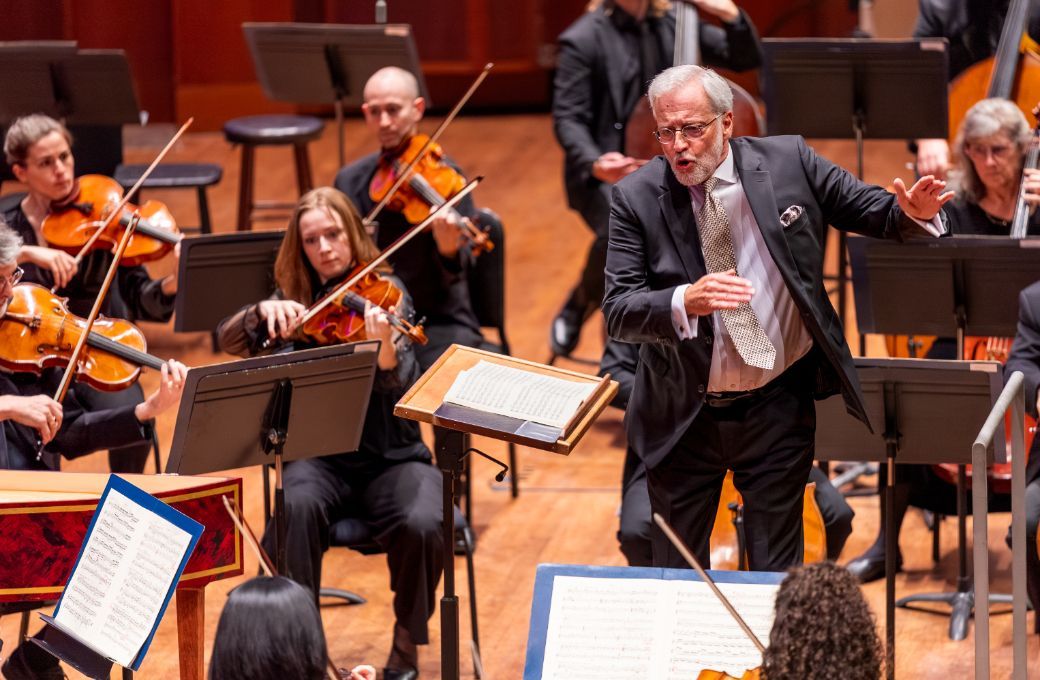The Seattle Symphony turned agile chamber band for its all-Baroque evening under guest conductor Ivars Taurins, joined by resident organist Joseph Adam. With the Seattle Opera season opening across town – the company orchestra comprises Seattle Symphony musicians – the program made a virtue of proportion and dramatic resourcefulness. All four works spanned the second quarter of the 18th century, when Georg Philipp Telemann, George Frideric Handel and Johann Adolph Hasse were active contemporaries – Telemann and Hasse in Germany, Handel in the twilight of his career as an English immigrant.

Taurins, a Canadian conductor best known as founding director of Toronto’s Tafelmusik Chamber Choir and an exponent of historically informed performance, shaped the musicians with a keen sense of Baroque style, from intimate clarity to the festive final blaze. On the podium, he embodied the music’s dance-like physicality, his gestures at times recalling the slow precision of Tai Chi.
While some of their colleagues were busy in the Seattle Opera pit, their counterparts in Benaroya Hall conjured drama without singers or staging. Telemann wrote his ten-movement Wassermusik to mark the centenary of Hamburg’s Admiralty in 1723. It unfolded as Baroque program music, steeped in the era’s fondness for mythological allegory. Each movement evokes a different facet of Hamburg as a thriving maritime center.
Taurins brought out Telemann’s vivid interplay of color and contrast, with crisp rhythmic articulation and bright repartee between winds and strings. In Der schertzende Tritonus (The joking Triton), playful bowed lines in the cellos were set against pizzicato strings, while swirling figures in the Aeolus movement highlighted the windkeeper’s stormy mischief – though chaos was held in check by the sure pulse of the dance. The suite culminated in a high-spirited send-off dance for Hamburg’s sailors as they prepare to set out to sea.
Handel’s D minor Organ Concerto offered a rare chance to appreciate the clarity and warmth of Benaroya Hall’s Watjen Concert Organ. Seated high in the central loft, resident organist Joseph Adam made it easy to imagine the composer himself delighting his London audiences between acts of an oratorio – the setting for which these concertos were originally written.
The D minor Concerto incorporates a direct nod to Telemann, a friend of Handel, transcribing one of his most infectious tunes for the sprightly second movement. In this section, following the concerto’s somber opening – where Efe Baltacıgil’s cello and Luke Fieweger’s bassoon added eloquent touches to the ensemble —Adam caught the playfulness of Handel’s sudden shifts in register with sly humor, tossing the melody between an almost circus-sparkle treble and darker middle voices. Apart from a few brief slips of synchronization, his rapport with the orchestra had an engagingly theatrical vitality.
Hasse’s Sinfonia in G minor was likely a discovery for many, a concise, three-part gem for strings and a welcome treat in a symphony concert. The composer’s operatic roots were unmistakable: bold contrasts, restless minor-key urgency and a lyrical Andante at the center that could easily serve as an aria without words. Taurins shaped the music with intense but stylishly controlled expressivity and dramatic purpose.
The evening culminated in the grandest musical spectacle with Handel’s Music for the Royal Fireworks, commissioned in 1749 by King George II to mark the conclusion of the War of the Austrian Succession. Handel had been compelled to cut the strings by order of the king, who insisted on more “martial” scoring, but they were happily restored in his version for full orchestra, balancing the brilliance of the brass and drums. Taurins coaxed a thrillingly full sound from the musicians, bursts of sonic fireworks unfolding into graceful symmetries – like strolling through the labyrinths of a musical garden.


